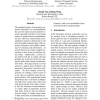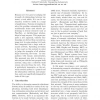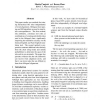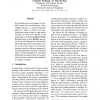COLING
2010
13 years 6 months ago
2010
Tibetan word segmentation is essential for Tibetan information processing. People mainly use the basic machine matching method which is based on dictionary to segment Tibetan word...
COLING
2010
13 years 6 months ago
2010
We describe a new information fusion approach to integrate facts extracted from cross-media objects (videos and texts) into a coherent common representation including multi-level ...
COLING
2010
13 years 6 months ago
2010
Hindi and Urdu share a common phonology, morphology and grammar but are written in different scripts. In addition, the vocabularies have also diverged significantly especially in ...
COLING
2010
13 years 6 months ago
2010
The potential benefit of integrating contextual information for recommendation has received much research attention recently, especially with the ever-increasing interest in mobil...
COLING
2010
13 years 6 months ago
2010
Humans are very good at judging the strength of relationships between two terms, a task which, if it can be automated, would be useful in a range of applications. Systems attempti...
COLING
2010
13 years 6 months ago
2010
The realization of singular count nouns without an accompanying determiner inside a PP (determinerless PP, bare PP, Preposition-Noun Combination) has recently attracted some inter...
COLING
2010
13 years 6 months ago
2010
In this paper, we propose a method for mediatory summarization, which is a novel technique for facilitating users' assessments of the credibility of information on the Web. A...
COLING
2010
13 years 6 months ago
2010
In this paper, we explore a CLIR-based approach to construct large-scale Chinese-English comparable corpora, which is valuable for translation knowledge mining. The initial source...
COLING
2010
13 years 6 months ago
2010
This paper studies two methods for training hierarchical MT rules independently of word alignments. Bilingual chart parsing and EM algorithm are used to train bitext correspondenc...
COLING
2010
13 years 6 months ago
2010
We introduce the novel problem of automatic related work summarization. Given multiple articles (e.g., conference/journal papers) as input, a related work summarization system cre...




